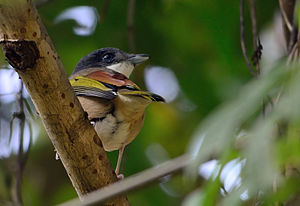White-browed shrike-babbler
| White-browed shrike-babbler | |
|---|---|

| |
| Male of subspecies validirostris at Namdapha National Park | |
| Scientific classification | |
| Domain: | Eukaryota |
| Kingdom: | Animalia |
| Phylum: | Chordata |
| Class: | Aves |
| Order: | Passeriformes |
| Family: | Vireonidae |
| Genus: | Pteruthius |
| Species: | P. aeralatus
|
| Binomial name | |
| Pteruthius aeralatus Blyth, 1855
| |

| |
| A rough distribution of the taxa within the species complex | |
The white-browed shrike-babbler (Pteruthius aeralatus) is a
cryptic species complex and was earlier lumped as a subspecies
of the white-browed shrike-babbler. Clements lumps this bird into the white-browed shrike-babbler.
Description


The white-browed shrike-babbler is sexually dimorphic. There are many variations between the populations and some are more distinctive than others but they may not be easy to diagnose in the field. In general appearance it is very similar to the Himalayan shrike-babbler but all subspecies with the exception of validirostris have the tertials of males partly coloured rufous and partly fulvous.

The common name commemorates Edward Blyth (1810–1873), who published the description and notes based on Samuel Tickell's specimen. It was earlier called Tickell's shrike-Tit.[2]
Taxonomy
The species was described by Edward Blyth who credited the name to collector Captain
phylogenetic species concept and these were reorganized with a smaller number of species resulting in the following subspecies being included within white-browed shrike-babbler.[6][7]
- The nominate form P. a. aeralatus described by Blyth in 1855 occurs in Burma and western Thailand.
- P. a. validirostris described by Koelz, 1951 is found from parts of eastern Nepal to western Burma. This includes the forms nocrecus and glauconotus which were also described by Koelz (who was known for being a "splitter").[8]
- P. a. ricketti described by Ogilvie-Grant in 1904 is found from northeastern Burma to southeast China and parts of Indochina.
- P. a. schauenseei described by Deignan in 1946 is found in southern Thailand[9]
- P. a. cameranoi described by Salvadori in 1879 is found in the Malay Peninsula and on the island of Sumatra.
- P. a. robinsoni described by Chasen & Kloss in 1931 is found in Borneo.
- P. a. ripleyi described by Biswas in 1960 is found in the western Himalayas east to central Nepal.
- P. a. annamensis described by Robinson & Kloss in 1919 is found in southern Vietnam.
References
- . Retrieved 18 November 2021.
- ^ Baker, E.C. Stuart (1922). The Fauna of British India, including Ceylon and Burma. Birds. Volume 1 (2 ed.). London: Taylor and Francis. p. 333.
- ^ Blyth, E. (1855). "Report of the Curator, Zoological Department, for April Meeting, 1855". Journal of the Asiatic Society of Bengal. 24: 252–281.
- ^ Baker, E.C. Stuart (1930). The Fauna of British India, including Ceylon and Burma. Birds. Volume 8 (2 ed.). London: Taylor and Francis. p. 609.
- ^ Mayr, E.; R.A. Paynter Jr., eds. (1964). Check-list of birds of the World. Volume 10. Cambridge, MA: Museum of comparative Zoology. pp. 385–387.
- PMID 18313946. Archived from the original(PDF) on 2014-03-25.
- .
- ^ Storer, R.W. (1988). Type specimens of birds in the collections of the University of Michigan Museum of Zoology (PDF). Ann Arbor: Museum of Zoology, University of Michigan.
- ^ Dickinson, E.C.; Chaiyaphun, Somtob (1968). "Notes on Thai Birds. 1. On a small collection of birds from in or near Nakhorn Ratchasima province, Eastern Thailand" (PDF). Nat. Hist. Bull. Siam Soc. 22: 307–315.
External links

